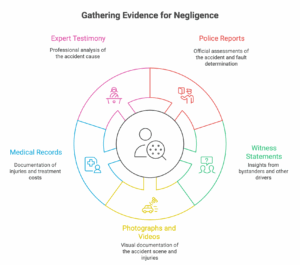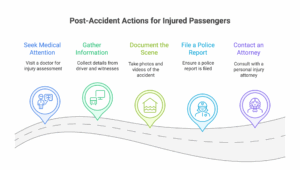Being a passenger in a car accident can be a confusing and stressful experience. If you’ve been injured, you’re likely wondering about your options for recovery. The key question often boils down to: was the driver negligent? Understanding the concept of driver negligence and its impact on your potential liability options is crucial for protecting your rights.
Passenger Injured in an Accident: Determining Negligence
The core principle in most personal injury cases is negligence. Negligence, in a legal sense, means that someone failed to act with reasonable care, and that failure directly caused harm to another person. In the context of a car accident, if the driver of the vehicle you were in acted negligently, they can be held liable for your injuries.
Understanding Driver Liability in Passenger Accidents
Several factors can establish a driver’s liability after a passenger accident. Here’s how:
- Violation of Traffic Laws: Speeding, running a red light, or failing to yield are clear examples of negligence. If the driver committed any traffic violation that led to the accident, it strengthens your claim.
- Distracted Driving: With the proliferation of smartphones, distracted driving is a significant cause of accidents. Texting, talking on the phone (even hands-free), or even adjusting the radio can be considered negligent behaviour if it contributed to the accident. According to the National Highway Traffic Safety Administration (NHTSA), distracted driving claimed 3,142 lives in 2020 alone.
- Driving Under the Influence (DUI): Driving under the influence of alcohol or drugs is inherently negligent. These cases are often more straightforward as the driver’s impairment is a clear breach of their duty of care.
- Drowsy Driving: Driving while fatigued can impair reaction time and judgment, similar to alcohol impairment. While it is harder to prove, evidence of drowsy driving (e.g., a driver admitting to being excessively tired) can support a negligence claim.
Establishing Driver Negligence After a Passenger Accident
Proving driver negligence requires gathering evidence. This includes:
- Police Reports: The police report is a crucial document that contains the officer’s assessment of the accident, including their determination of who they believe was at fault.
- Witness Statements: Statements from other drivers, passengers in different vehicles, or bystanders can provide valuable insights into the events leading up to the accident.
- Photographs and Videos: Photos of the accident scene, vehicle damage, and your injuries can help illustrate the severity of the accident and its consequences. Dashcam footage, if available, can be particularly compelling evidence.
- Medical Records: Your medical records document the extent of your injuries, the treatment you received, and the costs associated with your care.
- Expert Testimony: In some cases, expert witnesses, such as accident reconstruction specialists, may be needed to analyse the evidence and provide their professional opinion on the cause of the accident.

Passenger Rights: Compensation for Injuries Sustained in an Accident
As an injured passenger, you generally have the right to seek compensation for your damages. This can include:
- Medical Expenses: This covers all costs related to your medical treatment, including doctor visits, hospital stays, physical therapy, and prescription medications.
- Lost Wages: If your injuries prevent you from working, you can recover lost wages, both past and future.
- Pain and Suffering: This compensates you for the physical pain and emotional distress caused by your injuries. Calculating pain and suffering is often subjective and may depend on the severity of your injuries and their impact on your life.
- Property Damage: Although less common for passengers, if your personal belongings were damaged in the accident, you can seek compensation for their repair or replacement.
What to Do After an Accident as an Injured Passenger
Immediately after an accident, prioritise your safety and well-being:
- Seek Medical Attention: Even if you don’t feel immediately injured, it’s crucial to see a doctor as soon as possible. Some injuries, such as whiplash or internal bleeding, may not be immediately apparent. Documenting your injuries promptly is also crucial for your claim.
- Gather Information: If possible, collect information from the driver, including their insurance details. Also, collect contact information from any witnesses.
- Document the Scene: Use your phone to take photos and videos of the accident scene, vehicle damage, and your injuries.
- File a Police Report: Ensure that a police report is filed for the accident. This report will serve as a valuable piece of evidence in support of your claim.
- Contact an Attorney: Consult with a personal injury attorney as soon as possible. An attorney can advise you on your rights, help you gather evidence, and negotiate with the insurance company on your behalf.

Shared Liability: When the Passenger is Partly Responsible for the Accident
In certain situations, a passenger may be considered partially responsible for their injuries under comparative negligence laws. For example, if a passenger knowingly got into a car with a visibly intoxicated driver, a court might find them partially liable. This means their compensation could be reduced by the percentage of fault attributed to them. The specifics of comparative negligence vary from state to state.
Seeking Legal Guidance for Your Passenger Accident Claim
Navigating the legal process after a car accident can be a complex task. An experienced personal injury attorney can assess your case, explain your rights, and help you pursue the compensation you deserve. They can also help you understand how uninsured/underinsured motorist coverage may apply if the at-fault driver has insufficient insurance or is uninsured altogether. Don’t hesitate to seek legal guidance to protect your interests.




Do you mind if I quote a few of your posts as long as I provide credit and sources back to your blog? My website is in the very same area of interest as yours and my visitors would really benefit from a lot of the information you provide here. Please let me know if this alright with you. Regards!